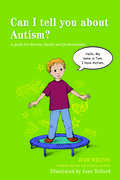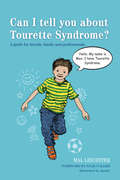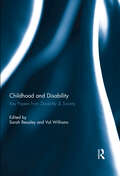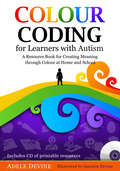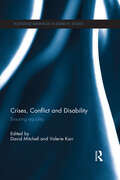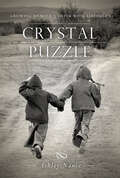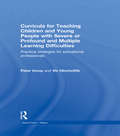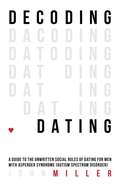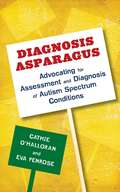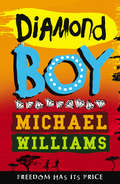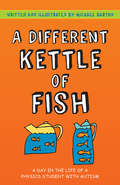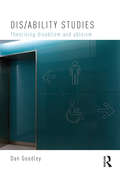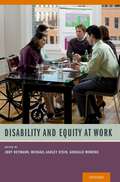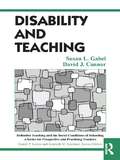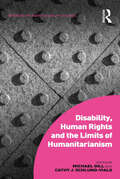- Table View
- List View
Can I tell you about Dyspraxia?: A guide for friends, family and professionals
by Maureen Boon Imogen HallamMeet Marco - a boy with dyspraxia, which is sometimes called Developmental Co-ordination Disorder (DCD). Marco invites readers to learn about dyspraxia from his perspective, helping them to understand what it is and what it feels like when he sometimes struggles to control his movement and co-ordination. He talks about the challenges of having dyspraxia and lets readers know how he can be helped and supported. This illustrated book will be an ideal introduction for young people, aged 7 upwards, as well as parents, friends, teachers and professionals working with children with dyspraxia. It is also an excellent starting point for family and classroom discussions.
Can I tell you about Dyspraxia?: A guide for friends, family and professionals (PDF)
by Imogen Hallam Maureen BoonMeet Marco - a boy with dyspraxia, which is sometimes called Developmental Co-ordination Disorder (DCD). Marco invites readers to learn about dyspraxia from his perspective, helping them to understand what it is and what it feels like when he sometimes struggles to control his movement and co-ordination. He talks about the challenges of having dyspraxia and lets readers know how he can be helped and supported. This illustrated book will be an ideal introduction for young people, aged 7 upwards, as well as parents, friends, teachers and professionals working with children with dyspraxia. It is also an excellent starting point for family and classroom discussions.
Can I tell you about Tourette Syndrome?: A guide for friends, family and professionals
by Julie Collier Apsley Mal LeicesterMeet Max - a boy with Tourette syndrome (TS). Max invites readers to learn about Tourette's from his perspective, helping them to understand what tics and triggers are and what it feels like to have TS. He explains how living with TS can sometimes be difficult, and how people around him can help him to feel happy and accepted. This illustrated book is ideal for young people aged 7 upwards, as well as parents, friends, teachers and other professionals working with children with TS. It is also an excellent starting point for family and classroom discussions.
Childhood and Disability: Key papers from Disability & Society
by Sarah Beazley Val WilliamsDrawn from Disability & Society over the period 1997-2012, the twelve chapters in this book address a range of personal, cultural and institutional arenas in which challenges experienced by disabled children are played out. The book includes a mix of theoretical and applied material offering both powerful conceptual tools and practical insights, enabling readers to connect the work of recent decades to their own research and questions about disability and childhood. Readers will find this book an invaluable resource for understanding what we have learned about disability and childhood through the pages of the world leading international journal in the field. The collection makes available a well-informed understanding of conditions, policies and practices that create disability in children's lives so that we can further the struggle for a more inclusive future in which inequalities structured around impairment are removed. The importance of children’s own voices for resisting disablement in childhood is clearly foregrounded in this invaluable collection.This book was originally published as a special issue of Disability & Society.
Childhood and Disability: Key papers from Disability & Society
by Sarah BeazleyDrawn from Disability & Society over the period 1997-2012, the twelve chapters in this book address a range of personal, cultural and institutional arenas in which challenges experienced by disabled children are played out. The book includes a mix of theoretical and applied material offering both powerful conceptual tools and practical insights, enabling readers to connect the work of recent decades to their own research and questions about disability and childhood. Readers will find this book an invaluable resource for understanding what we have learned about disability and childhood through the pages of the world leading international journal in the field. The collection makes available a well-informed understanding of conditions, policies and practices that create disability in children's lives so that we can further the struggle for a more inclusive future in which inequalities structured around impairment are removed. The importance of children’s own voices for resisting disablement in childhood is clearly foregrounded in this invaluable collection.This book was originally published as a special issue of Disability & Society.
Colour Coding for Learners with Autism: A Resource Book for Creating Meaning through Colour at Home and School (PDF)
by Adele DevineChildren on the autism spectrum are often highly visual learners, making colour a powerful and motivating learning tool. This book explains how colour coding helps young people with autism to generalise lessons already learnt. For example, assigning the colour aqua to all personal care activities or the colour purple to timetabling and transitions establishes clear, visual categories. This allows children to draw on learnt experiences, which creates a sense of order, reduces anxiety, and can aid communication, understanding emotions, organisation, coping with change and diversifying diet. A wealth of tried-and-tested printable resources to enable the practical application of colour coding in the classroom and at home are included on a CD-ROM. With colourful illustrations and resources, Colour Coding for Learners with Autism is an effective, must-have teaching tool for anyone involved in the education of young people with autism.
The Conversation Train: A Visual Approach to Conversation for Children on the Autism Spectrum (PDF)
by Joel ShaulThis inventive colour picture book uses the metaphor of a train to teach basic conventions of conversation to children with autism spectrum disorders (ASDs). Engines are like greetings; they get the train going. Freight wagons are like different speakers' turns; it is good to have at least a few when you are in conversation. A set of points guiding a train from one track to another is like a tactful change in the topic of conversation. When a conversation veers off-topic it is like a derailed train. As well as attractive colour photographs of trains, the book contains engaging photocopiable worksheets and colouring pages to help promote skill generalisation. This highly visual approach to conversation is ideally suited to children with ASDs aged approximately 5-13.
The Conversation Train: A Visual Approach to Conversation for Children on the Autism Spectrum
by Joel ShaulThis inventive colour picture book uses the metaphor of a train to teach basic conventions of conversation to children with autism spectrum disorders (ASDs). Engines are like greetings; they get the train going. Freight wagons are like different speakers' turns; it is good to have at least a few when you are in conversation. A set of points guiding a train from one track to another is like a tactful change in the topic of conversation. When a conversation veers off-topic it is like a derailed train. As well as attractive colour photographs of trains, the book contains engaging photocopiable worksheets and colouring pages to help promote skill generalisation. This highly visual approach to conversation is ideally suited to children with ASDs aged approximately 5-13.
Crises, Conflict and Disability: Ensuring Equality (Routledge Advances in Disability Studies)
by David Mitchell Valerie KarrPeople with disabilities are among the most adversely affected during conflict situations or when natural disasters strike. They experience higher mortality rates, have fewer available resources and less access to help, especially in refugee camps, as well as in post-disaster environments. Already subject to severe discrimination in many societies, people with disabilities are often overlooked during emergency evacuation, relief, recovery and rebuilding efforts. Countries party to the UN Convention on the Rights of Persons with Disabilities must take all necessary measures to ensure the protection and safety of people with disabilities during situations of armed conflict, humanitarian emergencies, and natural disasters. Such aid should be designed to support preparedness, response, recovery and rebuilding. This book includes perspectives from around the globe and explores the implications at the policy, programme, and personal level, discussing issues such as: How can national laws, policies, and regulations provide guidance, methods and strategies to integrate and coordinate inclusive emergency management? What should people with disabilities know in order to be prepared for emergency situations? What lessons have we learned from past experiences? What are the current shortfalls (physical and cultural) that put people with disabilities at risk during emergencies and what can be done to improve these situations (e.g. through new technologies and disaster planning)? How does disability affect people’s experiences as refugees and other displaced situations; what programmes and best practices are in place to protect and promote their rights during their period of displacement? How must disabled people with disabilities be factored in to the resettlement and rebuilding process; does an opportunity for ensuring universal access exist in the rebuilding process? What is the impact of disasters and conflicts on such special populations as disabled women, disabled children, and those with intellectual disabilities? Spotlighting a pressing issue that has long been neglected in emergency planning fields, this innovative book discusses how to meet the needs of people with disabilities in crises and conflict situations. It is an important reference for all those working in or researching disability and inclusion, and emergency and disaster management, both in developed and developing countries.
Crises, Conflict and Disability: Ensuring Equality (Routledge Advances in Disability Studies)
by Valerie Karr David MitchellPeople with disabilities are among the most adversely affected during conflict situations or when natural disasters strike. They experience higher mortality rates, have fewer available resources and less access to help, especially in refugee camps, as well as in post-disaster environments. Already subject to severe discrimination in many societies, people with disabilities are often overlooked during emergency evacuation, relief, recovery and rebuilding efforts. Countries party to the UN Convention on the Rights of Persons with Disabilities must take all necessary measures to ensure the protection and safety of people with disabilities during situations of armed conflict, humanitarian emergencies, and natural disasters. Such aid should be designed to support preparedness, response, recovery and rebuilding. This book includes perspectives from around the globe and explores the implications at the policy, programme, and personal level, discussing issues such as: How can national laws, policies, and regulations provide guidance, methods and strategies to integrate and coordinate inclusive emergency management? What should people with disabilities know in order to be prepared for emergency situations? What lessons have we learned from past experiences? What are the current shortfalls (physical and cultural) that put people with disabilities at risk during emergencies and what can be done to improve these situations (e.g. through new technologies and disaster planning)? How does disability affect people’s experiences as refugees and other displaced situations; what programmes and best practices are in place to protect and promote their rights during their period of displacement? How must disabled people with disabilities be factored in to the resettlement and rebuilding process; does an opportunity for ensuring universal access exist in the rebuilding process? What is the impact of disasters and conflicts on such special populations as disabled women, disabled children, and those with intellectual disabilities? Spotlighting a pressing issue that has long been neglected in emergency planning fields, this innovative book discusses how to meet the needs of people with disabilities in crises and conflict situations. It is an important reference for all those working in or researching disability and inclusion, and emergency and disaster management, both in developed and developing countries.
Crystal Puzzle: Growing Up with a Sister with Asperger's
by Ashley NanceA delightful, true story of growing up with a sister with Asperger's syndrome.
Curricula for Teaching Children and Young People with Severe or Profound and Multiple Learning Difficulties: Practical strategies for educational professionals (nasen spotlight)
by Peter Imray Viv HinchcliffeCurricula for Teaching Children and Young People with Severe or Profound and Multiple Learning Difficulties offers a range of compelling arguments for a distinct and separate pedagogical approach to the learning needs of the most educationally challenging pupils. This book, written in accessible, common sense and non-academic language, provides an easy-to-follow alternative curriculum specifically designed to enhance and enrich the learning of children with profound and multiple learning difficulties. Chapter by chapter, guidelines and support are offered in key curriculum areas, some of which include: Cognition Language, Literacy and Communication Mathematical Physical Sensory Creative Care Play Problem solving. This highly practical resource is essential reading for any educational professional, parents, school governors, teachers, teaching assistants, therapists and indeed anyone involved with maximising the educational opportunities of those with profound learning difficulties.
Curricula for Teaching Children and Young People with Severe or Profound and Multiple Learning Difficulties: Practical strategies for educational professionals (nasen spotlight)
by Peter Imray Viv HinchcliffeCurricula for Teaching Children and Young People with Severe or Profound and Multiple Learning Difficulties offers a range of compelling arguments for a distinct and separate pedagogical approach to the learning needs of the most educationally challenging pupils. This book, written in accessible, common sense and non-academic language, provides an easy-to-follow alternative curriculum specifically designed to enhance and enrich the learning of children with profound and multiple learning difficulties. Chapter by chapter, guidelines and support are offered in key curriculum areas, some of which include: Cognition Language, Literacy and Communication Mathematical Physical Sensory Creative Care Play Problem solving. This highly practical resource is essential reading for any educational professional, parents, school governors, teachers, teaching assistants, therapists and indeed anyone involved with maximising the educational opportunities of those with profound learning difficulties.
Decoding Dating: A Guide to the Unwritten Social Rules of Dating for Men with Asperger Syndrome (Autism Spectrum Disorder) (PDF)
by John MillerThe ultimate guide to cracking the social code of dating! The rules of dating are a conundrum for many men, but for men with Asperger Syndrome (Autism Spectrum Disorder) who often have difficulty understanding social communication, they can be almost indecipherable. This book methodically breaks down the steps of dating giving advice on the best places to meet women - whether on or offline, getting ready for the big date, where to go and what to talk about, and how to tell if a second date is on the cards. Written for those with little or no prior experience on the dating scene, the book discusses how to know if you are ready for a relationship, what qualities to look for in a potential girlfriend, and if dating goes well how to make a relationship work.
Diagnosis Asparagus: Advocating for Assessment and Diagnosis of Autism Spectrum Conditions
by Eva Penrose Catherine O'HalloranA highly readable, insightful and sometimes humorous account of autism assessment, diagnosis and life with a 'label'. Eva was diagnosed with Asperger Syndrome (ASD) at age 11 and is now a fun-loving, sociable 16-year-old. This book, co-written with her mother, a speech and language therapist, discusses their reasons for seeking a diagnosis, the process of being assessed, their reactions to the news and the impact it has had on Eva's life. It also considers how diagnosis has helped them find strategies to lessen the challenges of living with an ASD. Concluding that it doesn't really matter whether the name for the set of traits that characterise autism changes or what it changes to, this life-affirming book shows diagnosis to be a positive and empowering experience. It will be helpful to any family embarking on the assessment process as well as professionals looking for insight into a family's diagnosis journey.
Diagnosis Asparagus: Advocating for Assessment and Diagnosis of Autism Spectrum Conditions (PDF)
by Catherine O'Halloran Eva PenroseA highly readable, insightful and sometimes humorous account of autism assessment, diagnosis and life with a 'label'. Eva was diagnosed with Asperger Syndrome (ASD) at age 11 and is now a fun-loving, sociable 16-year-old. This book, co-written with her mother, a speech and language therapist, discusses their reasons for seeking a diagnosis, the process of being assessed, their reactions to the news and the impact it has had on Eva's life. It also considers how diagnosis has helped them find strategies to lessen the challenges of living with an ASD. Concluding that it doesn't really matter whether the name for the set of traits that characterise autism changes or what it changes to, this life-affirming book shows diagnosis to be a positive and empowering experience. It will be helpful to any family embarking on the assessment process as well as professionals looking for insight into a family's diagnosis journey.
Diamond Boy
by Michael Williams'Diamonds for everyone.' That's what fifteen-year-old Patson Moyo hears when his family arrives in the Marange diamond fields, leaving his previous life, school and friends behind with hopes for a better life. Soon Patson is working in the mines along with four friends in the Gwejana Syndicate – teen diamond miners, secretly pooling their profits and hoping to find the priceless stone that will change everything. But when the government's soldiers come to Marange, Patson's world is shattered. Set against the backdrop of President Mugabe's brutal regime in Zimbabwe, this is the story of a young man who succumbs to greed, but finds his way out through a transformative journey to South Africa in search of his missing sister, in search of freedom, and in search of himself.
A Different Kettle of Fish: A Day in the Life of a Physics Student with Autism
by Michael Barton Delia Barton"I'm looking at the Solar System display when I hear a child close by shouting at his mum, to which she replies 'No need to bite my head off!' I've heard of laughing your head off (to laugh a lot) and even biting your tongue (to be quiet) but biting someone's head off puts a rather more vivid picture into my mind!" During a trip to London, taking in tube announcements, guitar shops, and the Science Museum Michael Barton explores and explains the confusing "neurotypical" world of contradictory signage, hidden meanings and nonsensical figures of speech. His quirky and comic illustrations bring to life the journey from the comfort of his familiar university surroundings into the hectic bustle of central London. A fun and enlightening read for friends, family, caring professionals and anyone interested in an alternative viewpoint on the world. Sure to "strike a chord" with other day trippers on the autism spectrum.
A Different Kettle of Fish: A Day in the Life of a Physics Student with Autism (PDF)
by Delia Barton Michael Barton“I'm looking at the Solar System display when I hear a child close by shouting at his mum, to which she replies 'No need to bite my head off!' I've heard of laughing your head off (to laugh a lot) and even biting your tongue (to be quiet) but biting someone's head off puts a rather more vivid picture into my mind!” During a trip to London, taking in tube announcements, guitar shops, and the Science Museum Michael Barton explores and explains the confusing “neurotypical” world of contradictory signage, hidden meanings and nonsensical figures of speech. His quirky and comic illustrations bring to life the journey from the comfort of his familiar university surroundings into the hectic bustle of central London. A fun and enlightening read for friends, family, caring professionals and anyone interested in an alternative viewpoint on the world. Sure to “strike a chord” with other day trippers on the autism spectrum.
Dis/ability Studies: Theorising disablism and ableism
by Dan GoodleyIn this ground-breaking new work, Dan Goodley makes the case for a novel, distinct, intellectual, and political project – dis/ability studies – an orientation that might encourage us to think again about the phenomena of disability and ability. Drawing on a range of interdisciplinary areas, including sociology, psychology, education, policy and cultural studies, this much needed text takes the most topical and important issues in critical disability theory, and pushes them into new theoretical territory. Goodley argues that we are entering a time of dis/ability studies, when both categories of disability and ability require expanding upon as a response to the global politics of neoliberal capitalism. Divided into two parts, the first section traces the dual processes of ableism and disablism, suggesting that one cannot exist without the other, and makes the case for a research-driven and intersectional analysis of dis/ability. The second section applies this new analytical framework to a range of critical topics, including: The biopolitics of dis/ability and debility Inclusive education Psychopathology Markets, communities and civil society. Dis/ability Studies provides much needed depth, texture and analysis in this emerging discipline. This accessible text will appeal to students and researchers of disability across a range of disciplines, as well as disability activists, policymakers, and practitioners working directly with disabled people.
Dis/ability Studies: Theorising disablism and ableism
by Dan GoodleyIn this ground-breaking new work, Dan Goodley makes the case for a novel, distinct, intellectual, and political project – dis/ability studies – an orientation that might encourage us to think again about the phenomena of disability and ability. Drawing on a range of interdisciplinary areas, including sociology, psychology, education, policy and cultural studies, this much needed text takes the most topical and important issues in critical disability theory, and pushes them into new theoretical territory. Goodley argues that we are entering a time of dis/ability studies, when both categories of disability and ability require expanding upon as a response to the global politics of neoliberal capitalism. Divided into two parts, the first section traces the dual processes of ableism and disablism, suggesting that one cannot exist without the other, and makes the case for a research-driven and intersectional analysis of dis/ability. The second section applies this new analytical framework to a range of critical topics, including: The biopolitics of dis/ability and debility Inclusive education Psychopathology Markets, communities and civil society. Dis/ability Studies provides much needed depth, texture and analysis in this emerging discipline. This accessible text will appeal to students and researchers of disability across a range of disciplines, as well as disability activists, policymakers, and practitioners working directly with disabled people.
Disability and Teaching
by Susan Gabel David ConnorDisability and Teaching highlights issues of disability in K-12 schooling faced by teachers, whoare increasingly accountable for the achievement of all students regardless of the labelsassigned to them. It is designed to engage prospective and practicing teachers in examining theirpersonal theories and beliefs about disability and education. Part I offers four case studies dealing with issues such as inclusion, over-representation inspecial education, teacher assumptions and biases, and the struggles of novice teachers. Thesecases illustrate the need to understand disability and teaching within the contexts of school,community, and the broader society and in relation to other contemporary issues facing teachers.Each is followed by space for readers to write their own reactions and reflections, educators’dialogue about the case, space for readers’ reactions to the educators’ dialogue, a summary, andadditional questions. Part II presents public arguments representing different views about thetopic: conservative, liberal-progressive, and disability centered. Part III situates the authors’personal views within the growing field of Disability Studies in education and provides exercisesfor further reflection and a list of resources. Disability and Teaching is the 8th volume in the Reflective Teaching and the Social Conditions ofSchooling Series, edited by Daniel P. Liston and Kenneth M. Zeichner. This series of small,accessible, interactive texts introduces the notion of teacher reflection and develops it in relationto the social conditions of schooling. Each text focuses on a specific issue or content area inrelation to teaching and follows the same format. Books in this series are appropriate for teachereducation courses across the curriculum.
Disability and Teaching
by Susan Gabel David ConnorDisability and Teaching highlights issues of disability in K-12 schooling faced by teachers, whoare increasingly accountable for the achievement of all students regardless of the labelsassigned to them. It is designed to engage prospective and practicing teachers in examining theirpersonal theories and beliefs about disability and education. Part I offers four case studies dealing with issues such as inclusion, over-representation inspecial education, teacher assumptions and biases, and the struggles of novice teachers. Thesecases illustrate the need to understand disability and teaching within the contexts of school,community, and the broader society and in relation to other contemporary issues facing teachers.Each is followed by space for readers to write their own reactions and reflections, educators’dialogue about the case, space for readers’ reactions to the educators’ dialogue, a summary, andadditional questions. Part II presents public arguments representing different views about thetopic: conservative, liberal-progressive, and disability centered. Part III situates the authors’personal views within the growing field of Disability Studies in education and provides exercisesfor further reflection and a list of resources. Disability and Teaching is the 8th volume in the Reflective Teaching and the Social Conditions ofSchooling Series, edited by Daniel P. Liston and Kenneth M. Zeichner. This series of small,accessible, interactive texts introduces the notion of teacher reflection and develops it in relationto the social conditions of schooling. Each text focuses on a specific issue or content area inrelation to teaching and follows the same format. Books in this series are appropriate for teachereducation courses across the curriculum.
Disability, Human Rights and the Limits of Humanitarianism (Interdisciplinary Disability Studies)
by Michael Gill Cathy J. Schlund-VialsDisability studies scholars and activists have long criticized and critiqued so-termed ’charitable’ approaches to disability where the capitalization of individual disabled bodies to invoke pity are historically, socially, and politically circumscribed by paternalism. Disabled individuals have long advocated for civil and human rights in various locations throughout the globe, yet contemporary human rights discourses problematically co-opt disabled bodies as ’evidence’ of harms done under capitalism, war, and other forms of conflict, while humanitarian non-governmental organizations often use disabled bodies to generate resources for their humanitarian projects. It is the connection between civil rights and human rights, and this concomitant relationship between national and global, which foregrounds this groundbreaking book’s contention that disability studies productively challenge such human rights paradigms, which troublingly eschew disability rights in favor of exclusionary humanitarianism. It relocates disability from the margins to the center of academic and activist debates over the vexed relationship between human rights and humanitarianism. These considerations thus productively destabilize able-bodied assumptions that undergird definitions of personhood in civil rights and human rights by highlighting intersections between disability, race, gender ethnicity, and sexuality as a way to interrogate the possibilities (and limitations) of human rights as a politicized regime.
